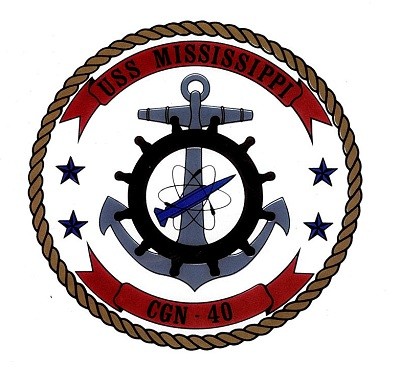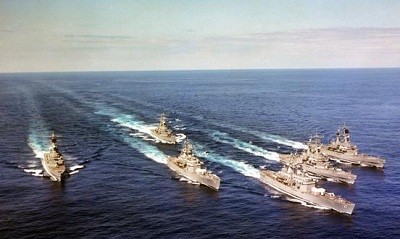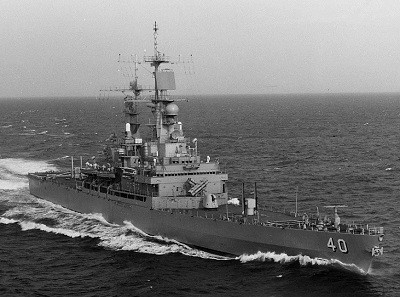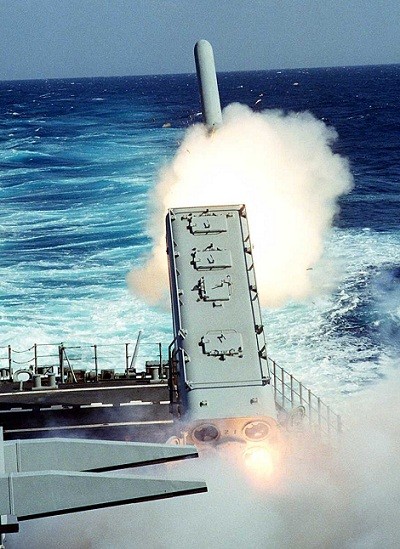Mississippi IV (CGN-40)

(CGN 40: displacement 11,737; length 586'; beam 63'; draft 32'; speed 30+ knots; complement 578; armament 4 RIM-24Tartar, 4 Antisubmarine Rocket (ASROC), 2 5-inch, 6 Mk 46 torpedoes; aircraft capability to land, service, hangar, and launch Light Airborne Multi-Purpose System (LAMPS) helicopters; class Virginia)
The first Mississippi was named for the Mississippi River; the succeeding ships for the 20th State, admitted to the Union on 10 December 1817.
IV
Mississippi (DLGN-40) was laid down on 22 February 1975 at Newport News, Va., by Newport News Shipbuilding & Dry Dock Co.; reclassified as a guided missile cruiser and designated CGN-40 on 30 June 1975; launched on 31 July 1976; sponsored by Miss. Janet H. Finch, daughter of Governor Charles C. Finch of Mississippi; and, in ceremonies attended by President James E. [Jimmy] Carter, Jr., Secretary of Defense Harold Brown, and Senator John C. Stennis of Mississippi, was commissioned at Norfolk, Va., on 5 August 1978, Capt. Peter M. Hekman, Jr., in command.
Mississippi conducted her shakedown cruise to Caribbean and South American waters (8 January–13 February 1979), then made her first deployment, to the Sixth Fleet in the Mediterranean, (3 August 1981–12 February 1982) during a confrontation between the United States and Libya. She operated as part of the screen for aircraft carriers Nimitz (CVN-68) and Forrestal (CV-59) when two Libyan Sukhoi Su‑22 Fitter-Js threatened the task force (19 August 1981). Cmdr. Henry M. Kleeman and Lt. David J. Venlet, and Lieutenants Lawrence M. Muczynski and James Anderson, of Fighter Squadron (VF) 41, manned a pair of Grumman F‑14A Tomcats on a reconnaissance mission from Nimitz for a missile-firing exercise during freedom of navigation operations over international waters. The Libyans opened fire at the Tomcats and the F-14As shot down the Fitter-Js with AIM-9L Sidewinder air-to-air missiles. Mississippi fired three RIM-66B Standard SM-1 surface-to-air missiles during the exercise.
While Mississippi steamed with Nimitz and guided missilecruiser Arkansas (CGN 41) off the coast of Lebanon, she received a distress call from Greek cargo vessel Andalusia, registered with the Belgravia Maritime Company of London, England, bearing 166°, range 26 nautical miles (0030 on 3 December 1982). Crew 11, a Lockheed P-3C Orion from Patrol Squadron (VP) 49, vectored Mississippi to Andalusia and the cruiser rescued all 19 crewmembers. Two Sikorsky Sea Kings from Helicopter Antisubmarine Squadron (HS) 9 operating from Nimitz, an SH-3H designated AJ 615, pilotLt. Michael G. Mulcahy, copilot Lt. (j.g.) Randall K. Ewald, and aircrewmen Aviation Antisubmarine Warfare Operator 2d Class Robert S. Chronister and Aviation Antisubmarine Warfare Operator Airman Henry J. Miller; and an SH-3G designated AJ-617, BuNo 149000, pilot Lt. Cmdr. David B. Small, Jr., copilot Lt. Cmdr. Larry W. Zimmer, and aircrewmen Aviation Antisubmarine Warfare Operator 2d Class Richard M. Lane and Aviation Antisubmarine Warfare Operator Airman Allen L. Estel; transferred survivors from Mississippi to the carrier. Mississippi’s chief engineer and damage control assistant inspected Andalusia but determined that her damage precluded salvage, and the ship sank at 0824, 1,200 yards off the port bow of the cruiser in 195 fathoms (36°1'N, 12°19'2"E).

Arab terrorists in Beirut, Lebanon, kidnapped and hung Lt. Col. William R. Higgins, USMC, a member of the UN peacekeeping forces in Lebanon, and threatened to murder additional hostages they held (1 August 1989). Aircraft carrier America (CV 66) departed early from a visit to Singapore and made for the Arabian Sea, and Coral Sea (CV 43) steamed from Alexandria, Egypt, to the Eastern Mediterranean as a show of force. Mississippi had deployed as part of the Sixth Fleet’s Med 3-89 Battle Force and was visiting Haifa, Israel, when the crisis began. She emergency sortied and operated as the battle group’s Composite Warfare Coordinator for antisurface warfare off the Lebanese littoral throughout the remainder of the month. Midway (CV-41) had originally been scheduled to participate in Pacific Exercise-89, but sailed to fill a carrier commitment in the Indian Ocean, where she operated until mid-October.
Mississippi deployed with the John F. Kennedy (CV-67) Battle Group to the Mediterranean for Operations Desert Shield/Storm/Sabre, the liberation of the Kuwaitis from the Iraqis (16 August 1990–28 March 1991). She escorted ammunition ship Nitro (AE-21) through the Bab al Mandeb into the Gulf of Aden (18 January) and then made flank speed to her launch position in the Red Sea. Mississippi fired three BGM-109 Tomahawk Land Attack Missiles (TLAMs) at Iraqi strategic and military targets (25 January 1991) and two more the following day. The ship then operated as the local Antiair Warfare Screen commander for the Red Sea Battle Force (27 January–24 February).
Following the Haitian Army’s overthrow of President Jean-Bertrand Aristide (September 1991), a succession of governments led to sectarian violence. The UN authorized force to restore order and the U.S. initiated Operations Support Democracy and Uphold/Restore Democracy/Uphold Democracy for a peaceful entry into Haiti, and Restore Democracy in the event of resistance. Mississippi enforced the embargoes imposed upon Haiti as part of Support Democracy (14 July–3 August). The deteriorating situation then (12 September 1994) prompted the dispatch of a multinational force that included America (CV 66) and Dwight D. Eisenhower (CVN 69), about 1,800 soldiers of the Army’s XVIII Airborne Corps embarked on board Dwight D. Eisenhower. The Haitians agreed to allow the Americans to land peacefully, and (31 March 1995) the U.S. transferred peacekeeping functions to international forces. The crisis marked the first deployment operationally of Army helicopters on board a carrier in lieu of most of an air wing.

NATO and the UN carried out Operations: Provide Promise to provide humanitarian relief for people displaced by the fighting in former Yugoslavia (2 July 1992–9 January 1996); Deny Flight to monitor the air space over Bosnia-Herzegovina to prevent the warring parties from using their air strength (12 April 1993–21 December 1995); and Sharp Guard to enforce the arms embargo against the combatants (15 June 1993–2 October 1996). Mississippi served as Red Crown, coordinating air operations, in the Maverick Operating Area in the Adriatic Sea (2–18 April, 14–21 May, 11–21 June, 30 June–9 July, 22–27 July, and 22 August–6 September 1995). In addition, the cruiser intercepted Polish vessel Dajti, and her boarding team boarded and inspected the Eastern European ship as a possible smuggler (7 April).
Two Cuban Mikoyan Gurevich MiG-29UB Fulcrums shot down two Cessna 337 Skymasters flown by the “Brothers to the Rescue,” a non-profit organization opposed to the Cuban government of Fidel R. Castro, over contested international waters (24 February 1996). Mississippi led a surface action group that included guided missile cruiser Ticonderoga (CG 47) and guided missile frigate John L. Hall (FFG 32) during Operations Sentinel Lifeguard, Standoff IV, and Escort 1-96 in the Straits of Florida in response to the Cubans’ downing the Skymasters (25–28 February and 1–7 March). In addition, the group escorted a civilian flotilla that laid a wreath on the water where the victims fell.
Mississippi was deactivated on 6 September 1996 at Norfolk, and decommissioned there on 28 July 1997. Pending the cruiser’s further disposition, the Military Sealift Command-operated fleet ocean tug Mohawk (T-ATF 170) took Mississippi under tow to Rodman, Panama Canal Zone, and Navajo (T-ATF 169) towed her from there to the Naval Sea Systems Command Inactive Ships Onsite Maintenance Office, Puget Sound Naval Shipyard, Bremerton, Wash. (March–May 1998). Circa October 2004, she entered the Ship/Submarine Recycling Program (SRP), the Navy’s program to dispose of decommissioned nuclear powered vessels.
Detailed history under construction.
Last Reviewed: 12/11/13
Mark L. Evans



